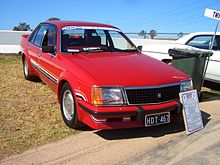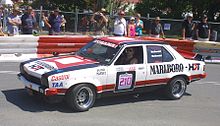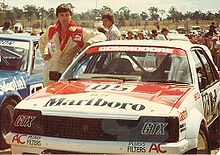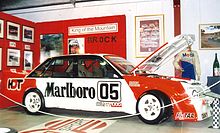- Holden Dealer Team
-
HDT Manufacturer Holden, later BMW & Ford Team Principal Harry Firth (69-77), John Sheppard (78-79), Peter Brock (80-93) Team Manager Harry Firth (69-77), John Sheppard (78-79), Peter Brock (80-81), Grant Spears (82-86), Graham Browne (87), Alan Gow Race Drivers (Touring Cars) Peter Brock, Colin Bond, John Harvey, Charlie O'Brien, Larry Perkins, David Parsons, Gary Scott, Jim Richards, Neil Crompton, Tony Roberts, Barry Ferguson, Des West, Peter Macrow, Henk Woelders, Sandra Bennett, Christine Gibson, Bob Morris, Doug Chivas, Leo Geoghegan, Bob Skelton, Brian Sampson, Johnnie Walker, Wayne Negus, Ron Harrop, Vern Schuppan, Phil Brock, David Oxton, Allan Moffat, Neal Lowe, Jon Crooke, Peter McLeod, Kent Baigent, Graeme Bowkett, Brad Jones, Mark Larkham, Andy Rouse, Andrew Miedecke, Tomas Mezera, Manuel Reuter, Troy Dunstan, Steve Harrington & John Cleland. Chassis Holden Monaro (HT), Holden Torana (LC, LJ, LH, LX), Holden Commodore (VB, VC, VH, VK, VK SS Group A, VL SS Group A, VN SS Group A SV, VP), BMW M3, Ford Sierra RS500 Debut 1969 Drivers' Championships 4 Round wins 38 1993 position 8th (Brock) The Holden Dealer Team (aka HDT) was Holden’s semi-official racing team from 1969 until 1987, primarily contesting Australian Touring Car events but also rallying, rallycross and sports sedans during the 1970s. From 1980 the Holden Dealer Team, by then under the ownership of Peter Brock, diversified into producing modified Commodores and other Holden cars for selected dealers via HDT Special Vehicles Pty Ltd.
Holden ceased its association with Brock's businesses in February 1987, and for the remainder of that year the race team became known as HDT Racing, which name was later dissolved when Brock secured a contract with BMW Australia to operate a BMW M3 race team (formerly JPS Team BMW) in 1988. Further into 1988, Brock sold off his HDT Special Vehicles road car business, which has nevertheless under various ownership continued to modify Holden vehicles to this current day.
Contents
The Firth Years
After showing an increasing interest in motorsport during the 1960s, Holden decided to form a team to enter both Touring Car and Rally events in 1969. However, Holden’s parent company, General Motors forbade its manufacturers from officially entering motor sport circuit racing events. Holden was able to circumvent this directive by naming its team the ‘Holden Dealer Team’ which was officially owned by its dealers. In reality Holden bankrolled the entire operation and Holden executive John Bagshaw, who was the driving force behind the establishment of the team, created the financial framework which allowed the HDT to be funded without Detroit's knowledge. Holden appointed former Ford team manager Harry Firth to manage the operation.
Harry Firth hired two talented, but relatively untested, drivers in Colin Bond and Peter Brock. These two drivers would form the backbone of the team over the next few years. At that year's Hardie-Ferodo 500 the team entered three HT Monaro GTS350’s and tasted immediate success, finishing first and third, with Bond winning with co-driver Tony Roberts, while Brock finished third with Des West.
Concerned at the ongoing development of rival Ford’s V8 powered XW Falcon GTHO Phase I, in 1970 Firth opted to run a much smaller race car based upon the Holden Torana with a 6-cylinder engine. The LC Torana GTR XU-1 was a match for the larger and more powerful Falcon GT-HO at most circuits, but at Bathurst, with its long straight and steep 'mountain' climb, the car was less competitive, and Ford’s Allan Moffat dominated both the 1970 and 1971 events. However in 1972 the Holden Dealer Team with its LJ Torana GTR XU-1 broke through Ford's domination, with Peter Brock winning the first of his nine Bathurst victories in a solo drive in the last of Bathurst's 500 mile Series Production race formats.
Rallying and Rallycross
Holden had been supporting rally adventures since the early 1960s and had made use of the brand's successes in its advertising ... support had often been arranged via dedicated state 'dealer' teams, however it was not until 1969 that the whole arena of rallying and Holden motor sport in general was grouped together under the management of Harry Firth and the Holden Dealer Team. The new team kicked off in August 1969 with Harry himself behind the wheel of a HT Monaro GTS 253 rally car, but he soon after announced his retirement from active driving, handing over the rally Monaro to his old rival, Barry Ferguson. Colin Bond and Tony Roberts then joined in as additional members of the rally team.
In 1970, the rally team ran a Monaro GTS 350 for Bond whilst Ferguson and Roberts each drove the new Torana GTRs. As the team progressed, Colin Bond in partnership with George Shepheard won the Australian Rally Championship three times in 1971, 1972 and 1974 driving the LC Torana GTR XU-1 and later the LJ Torana GTR XU-1. During this period, Peter Brock proved himself to be very successful in Rallycross races at Calder Park Raceway in Victoria and Catalina Park in New South Wales, driving HDT's famous Holden Torana GTR called "The Beast". In Brock's hands this supercharged version of a LC Torana GTR proved virtually unbeatable.
LJ Torana GTR XU-1 V8
In 1972, Harry Firth began developing a V8-engined version of the LJ Torana GTR XU-1, to be able to compete with Ford's anticipated XA Falcon GT-HO (Phase IV) and Chrysler's mooted 340ci V8 Charger at Bathurst (Chrysler continue to this day to say that the Charger R/T V8 was a myth but Ford's GT-HO Phase IV definitely wasn't). The first V8 Torana was fitted with the small block 253ci (4.2L) Holden V8 but this was soon upgraded to the 308ci (5.0L) version. This car was built to Series Production rules at the time but Harry Firth had Colin Bond race the car, disguised as a Sports Sedan, at the 1972 Easter ATCC race meeting at Bathurst. Bond took an easy victory in the five lap support race with a lap time some four seconds faster than the team's 6-cylinder Series car. Unfortunately, the production potential of this car ended up going nowhere in the wake of the Supercar Scare of June/July 1972.
LH Torana L34 and LX Torana A9X
In 1974 Holden released the larger but significantly more powerful V8 powered LH Torana SL/R 5000. Peter Brock dominated the Australian Touring Car Championship that year, using both a LJ-series GTR XU-1 and then the new LH-series SL/R 5000. Both Brock and Bond suffered engine problems with the new L34 Option variant of the SL/R 5000 at Bathurst in 1974, putting them out when the team seemed to be in an unassailable position (the Brock/Sampson car was six laps in front when it retired on lap 118).
At the end of the 1974 season Brock left the HDT team, whilst Colin Bond continued on as the team's sole circuit racing driver. Bond went on to win the 1975 Australian Touring Car Championship whilst also competing in rally events for HDT in a LH Torana SL/R 5000 L34.
HDT's circuit racing presence returned to a two-car status for 1976, initially with John Walker joining the team, but following his departure along came John Harvey. In 1977, Colin Bond departed HDT to join Alan Moffat’s semi-works "Moffat Ford Dealers" team. Thereafter, John Harvey became the HDT principal driver, to be joined by Charlie O'Brien.
The 1977 touring car racing season also saw the debut of the LX Torana, the new A9X performance option replacing the L34 version and available in both four-door "SL/R 5000" sedan and two-door "SS 5.0" hatchback body types. However, due to teething troubles with this new homologation special, the Holden Dealer Team struggled against the two-car Moffat Ford Dealers team, with Allan Moffat winning both the 1977 ATCC title and also the big one at Bathurst.
After a solid eight years, Harry Firth parted ways with the Holden Dealer Team at the end of the 1977 season.
John Sheppard takes over
One of the first moves made by Sheppard was to bring Brock back to the team. It was a wise decision for Brock dominated the season, becoming the first driver to win the 'triple crown' of the Touring Car Championship, the Hang Ten 400 at Sandown and the Hardie-Ferodo 1000 (with Jim Richards).
Brock was narrowly defeated by privateer Torana driver Bob Morris for the 1979 Australian Touring Car Championship but went on to dominate the Hardie-Ferodo 1000. Brock qualified on pole position, he and Richards lead every lap of the race, Brock set a new lap record on the very last lap of the race and they won by a massive six-lap margin.
The Holden Dealer Team also entered a three-car Commodore team in the Round Australia Rally. Anxious to prove the then new cars reliability, the cars were perfectly prepared and finished first, second and third. Brock, who won the event along with co-drivers Matt Phillip and Noel Richards, has cited this event as his career highlight.
The Brock era
Despite the success, by 1980 Holden was ready to pull the pin on the Holden Dealer Team. They believed there was no longer any point in competing against privateer teams driving Holden cars, and they put the team up for sale. Peter Brock purchased the team, and in order to finance it, called on Holden dealers to support him. In return for providing assistance, Brock would build a special range of modified, high performance Commodores for the dealers to add to their range. (See section on HDT Special Vehicles below). For the first time, the team really was a 'Dealer Team'. Meanwhile, Brock also took over the management of the racing team as John Sheppard had left the team when Holden pulled out.
Despite the off track changes, the Holden Dealer Team remained as competitive as ever, with Brock claiming a second 'triple crown'. This time his Bathurst adventure was less straightforward. Chasing Dick Johnson's Ford XD Falcon early in the race, Brock collided with a back marker. The damage was only minor but Brock went a lap down whilst his car was repaired. Soon after however, Johnson hit a rock on the top of the mountain and was out of the race, and Brock and Richards fought their way back throughout the day to score a come from behind win.
While the Holden Dealer Team was unable to win another Touring Car Championship, the team maintained its excellent Bathurst record over the next few years. Brock won Bathurst again in 1982 with former Formula One driver Larry Perkins, and again in controversial circumstances in 1983. The rules at the time permitted 'cross-entering' which meant that after Brock's car dropped out with an engine failure, both Brock and Perkins transferred into John Harvey's car, leaving Peter's younger brother Phil, who was to be Harvey's co-driver, without a drive. The trio then went on to win the race. For 1984 Brock and Perkins made it three in a row and the team made it a 1-2 when John Harvey and new recruit David Parsons crossed the line right behind, but 2 laps back, Brock in a form finish.
Group A
In 1985 Australian touring car racing now ran under International Group A formula, rather than the indigenous Group C regulations that had been in force since 1973. This led indirectly to the Holden Commodores becoming less competitive against the imported Nissans, Volvos, BMWs and Jaguars. Despite only one win during the season, Brock nearly pulled off an upset podium at Bathurst, retiring due to a broken timing chain three laps from the end of the race while running a strong second. By 1986, a homologated version of the car, originally to be released in 1985, made the Commodore much more competitive, and Brock was able to sign longtime rival Allan Moffat to the team. The HDT, taking advantage of Group A regulations, also ran a European Touring Car Championship program. Due to the liberal nature by which European regulators enforced the rules, the HDT was not as competitive as they hoped, but they still achieved some successes, such as co-winning the Kings Cup team's prize at the Spa 24 Hours with Allan Grice's Australian Racing Team. The HDT's best ETCC finish was a 5th place at Donington Park.
By 1987 the relationship between Brock and Holden had soured, primarily over the controversial 'energy polarizer' device Brock was installing in the HDT road cars (see below). Moffat and Harvey both left the team, HDT's 1987 international campaign was limited to an assault on Spa and team did not pose a threat in that year's championship. That year the Bathurst 1000 was a round of the World Touring Car Championship and Rudi Eggenberger's Texaco Ford Sierra RS500s dominated the race. Brock's own car failed early but he and co-driver David Parsons cross-entered into the teams second car, driven by Peter McLeod and made up ground in the wet conditions, and eventually finished in third place behind the two Sierras. Ten months later, the Sierras were disqualified for running illegal bodywork and Brock, Parsons and McLeod became the victors.
Advantage Racing
The team continued under the direction of Alan Gow under the banner of Advantage Racing, with continued support from Mobil, but without the assistance of Holden, new automotive partners had to be found. Frank Gardner had retired and shut down the JPS Team BMW. The team bought the JPS team assets and became the official team for BMW Australia but by 1988 the BMW M3 was no longer competitive and Brock, Jim Richards and emerging talent Neil Crompton found themselves fighting for scraps against the onslaught of the Ford Sierras. By the 1989 ATCC season Brock was forced into the unthinkable and spent the next two years racing Ford's Sierra RS500s, supplied in kit form by Andy Rouse. Limited budget forced the team into a merger with Miedecke Motorsport in 1990.
The venture with Ford was not without success, with race wins returning and coming within a few points of winning the 1990 Australian Touring Car Championship. Another highlight was pole position at the 1989 Tooheys 1000. Budget constraints again forced the team into a technical alliance with Larry Perkins and Perkins Engineering for the 1991 Australian Touring Car season, bringing with it a return to Holden, running the VN Commodore Group A SS, however this coincided with the highpoint for Nissan with their all wheel drive, twin turbo GT-R which left everyone in Group A behind, leaving Brock and Perkins again scrabbling for points rather than podiums.
The alliance with Perkins lasted just a single season, and Advantage continued through into the beginning of the V8 Supercar era with Commodores with modest success until he reconciled with Holden and was invited to join Holden's new official racing team, the Holden Racing Team in 1994. At this point Advantage disbanded, the last remnants of the Holden Dealer Team going separate ways.
Peter Brock's HDT Special Vehicles P/L
 1980 VC Commodore HDT sedan in Firethorn Red.
1980 VC Commodore HDT sedan in Firethorn Red.
 A slightly modified 1982 VH Commodore SS Group 3 sedan in Maranello Red.
A slightly modified 1982 VH Commodore SS Group 3 sedan in Maranello Red.
 A slightly modified 1985 VK Commodore SS Group A sedan in Formula Blue. This model is nicknamed Blue Meanie by enthusiasts.
A slightly modified 1985 VK Commodore SS Group A sedan in Formula Blue. This model is nicknamed Blue Meanie by enthusiasts.
The cars built by HDT Special Vehicles for road use quickly gained an enthusiastic following. The cars were built under Peter Brock's direction and had approval from Holden. Several versions of modified high-performance road-going Commodore sedans were produced through the early and mid 1980s, with some being "homologation specials" produced to meet the prevailing Group A racing regulations. These vehicles were all individually numbered with only 4246 Brock HDT's made and are considered to be collectors' items due to their rarity.
HDT and Brock's association with Holden ended sensationally in 1987, after Brock began fitting a device known as the "Energy Polarizer" to HDT vehicles. Regarded as pseudoscience by Holden and the vast majority of the Australian motoring community, a new VL series "Director" model was then released in February 1987 which incorporated not only the Polarizer but also a new independent rear suspension system developed by HDT without Holden's approval. Holden ended its association with Brock as he had refused to supply a Director for test purposes and Holden was therefore unwilling to honour warranties on any cars thereafter modified by Brock's HDT operation.
Holden, in a partnership of sorts with TWR, then set up Holden Special Vehicles, which business took over the role of producing factory-approved modified Commodores for general road use as well as for Group A racing homologation.
Legacy and collectibility
The HDT Commodores have a substantial place in Australian motoring enthusiast history, and thus they are highly collectible. It is not uncommon to see these vehicles selling for over $60,000 for a clean genuine example or even between $80-150,000 for an extremely low km example.
Enthusiasts in many Australian States have formed HDT Owners Groups, having regular concourse events, showcasing the many fine examples that HDT produced over the years.After the death of Brock, HDT vehicles became more collectible than ever. According to the Australian 5/2007 Wheels Magazine showroom condition cars are generating prices as high as $200,000 AU.[citation needed]
The HDT Cup
The HDT Cup is a category that celebrates a "Golden Era" in Australian Motor Sport. The "Holden Dealer Team" started in 1969 with the HT Monaro, subsequently moving on to the XU1 Torana, going on to race Toranas for 9 years. HDT switched over to Commodores after their introduction and campaigned Commodores for a further 8 years. The HDT Cup was introduced to iRace in 2009 after a request from HDT to become involved with the series. In 2009 "Classic" [pre 1987] and "Modern" [post 1987] classes for Commodores made up the HDT Cup. For 2010 a Torana class will also be introduced. The cars are split into classes based on engine capacity:
- Class "A" is for engines over 5 Ltrs,
- Class "B" is for the 253 V8, and
- Class "C" for six cylinder cars of both V and inline configuration.
HDT Muscle Division
The HDT Muscle Division caters for all types of production-based racing cars. From the venerable HQ Holdens, to V8-powered Ford and Holden Utes, to ex-Commodore Cup cars, Improved Production, Sports Sedans (non-spaceframe) and Japanese Turbos, as well as Classic Touring Cars and more.
Brock era HDT road cars
Vehicle types manufactured in partnership with Holden :
- VC COMMODORE HDT - 5.0 ltr
- VH COMMODORE ADP - various sedan and wagon vehicles - 4.2 ltr, 5.0 ltr
- VH COMMODORE SS GROUP ONE - 4.2 ltr
- VH COMMODORE SS GROUP TWO - 4.2 ltr
- VH COMMODORE SS GROUP THREE - 4.2 ltr, 5.0 ltr
- WB STATESMAN DE VILLE MAGNUM - 5.0 ltr
- WB STATESMAN CAPRICE MAGNUM - 5.0 ltr
- VK COMMODORE LM5000 - 5.0 ltr
- VK COMMODORE ADP - various sedan and wagon vehicles - 5.0 ltr, 4.9 ltr
- VK COMMODORE ADP (SL GROUP A) - 5.0 ltr, 4.9 ltr
- VK COMMODORE SS - 5.0 ltr, 4.9 ltr
- VK COMMODORE SS GROUP THREE - 5.0 ltr, 4.9 ltr
- VK CALAIS DIRECTOR - 5.0 ltr, 4.9 ltr
- VK COMMODORE SS GROUP A - 4.9 ltr
- VK COMMODORE SS GROUP A GROUP THREE - 4.9 ltr
- VL CALAIS LE - 3.0 ltr, 3.0 ltr Turbo, 4.9 ltr
- VL CORSA (COMMODORE LE) - 3.0 ltr, 3.0 ltr Turbo
- VL COMMODORE SS GROUP A - 4.9 ltr
- VL COMMODORE SS GROUP A "Plus Pack" - 4.9 ltr
Vehicle types manufactured following dissolution with Holden :- VL HDT DIRECTOR - 4.9 ltr, 5.6 ltr
- VL HDT GROUP THREE - 4.9 ltr
- VL HDT DESIGNER SERIES - various sedan and wagon vehicles - 3.0 ltr, 3.0 ltr Turbo, 4.9 ltr
- VL HDT AERO - 4.9 ltr, 5.6 ltr
- VL HDT BATHURST - 4.9 ltr, 5.6 ltr
In addition to the Holden/HDT mainstream editions listed above, various 'one-off' vehicles were manufactured by HDT Special Vehicles during the 1980-1988 period, perhaps the most significant of those being the HDT MONZA hatchback coupe that was displayed around Australia in 1985 with hopes of production that unfortunately did not eventuate.New Generation
In May 2007, Peter Champion, a good friend of Peter Brock, purchased the HDT Special Vehicles business. Since then a 'New Generation' of road vehicles based around the VE Commodore have been developed. HDT's VE Commodore sedans form the new "Heritage Series" and these "Retro" cars are themselves based upon iconic HDT special vehicle designs of the Brock era. The first of these 'New Generation' HDT cars is called the VC Retro sedan, appropriately styled upon Brock's first public release vehicle, the VC HDT Commodore sedan of late 1980.[1]
HDT Heritage Series[2]
- VC RETRO sedan - based upon VE SV6, SS, and SS-V
- VC/VE RETRO 30TH ANNIVERSARY sedan - based upon VE SS and SS-V
- VH RETRO sedan - based upon VE SV6, SS, and SS-V
- VK GROUP A RETRO sedan - based upon VE SS and SS-V
- VK GROUP 3 RETRO sedan - based upon VE SS and SS-V
See also
- Holden Dealer Racing Team (1968 precursor of the HDT)
- List of Championships won by the Holden Dealer Team
External links
References
- ^ HDT Special Vehicles - The Story, Official Website.
- ^ HDT Special Vehicles - current releases, Official Website.
Categories:- Holden in motorsport
- V8 Supercar teams
- Australian auto racing teams
- Sports teams in Victoria (Australia)
- Official motorsport and performance division of automakers
Wikimedia Foundation. 2010.





